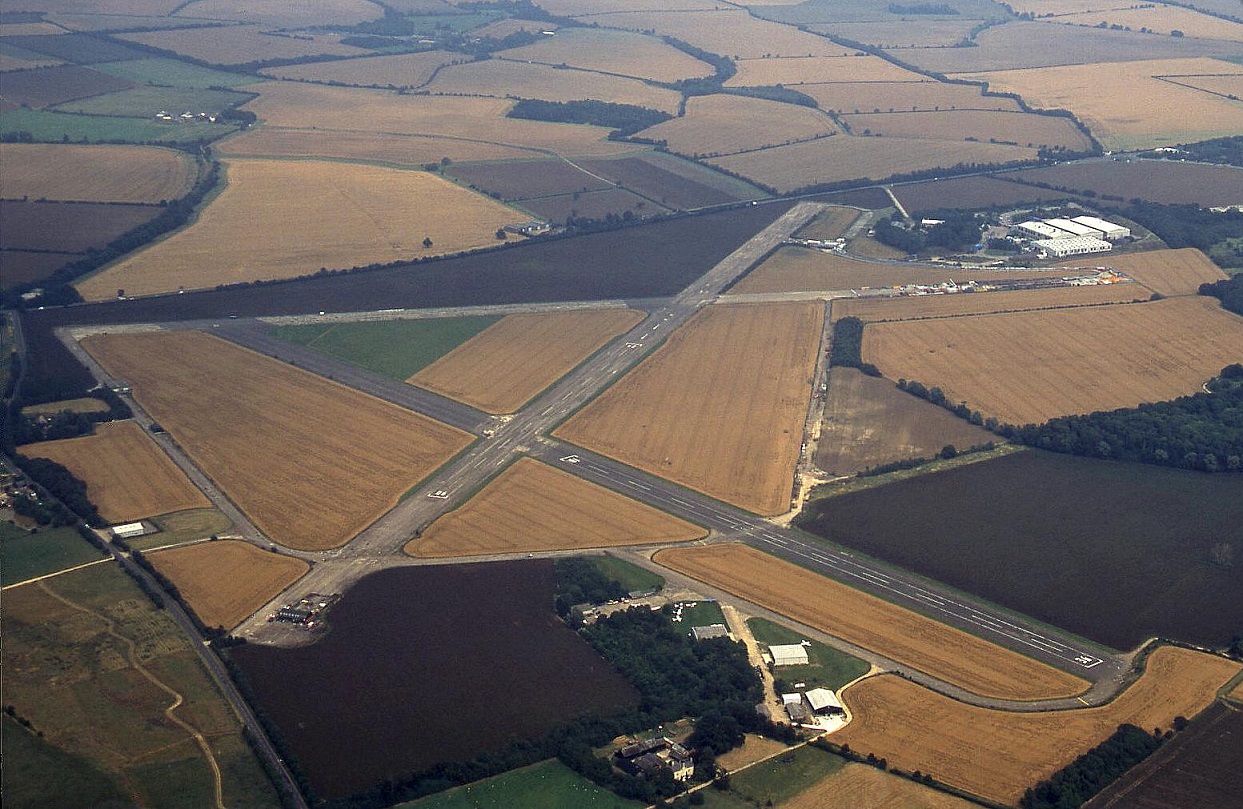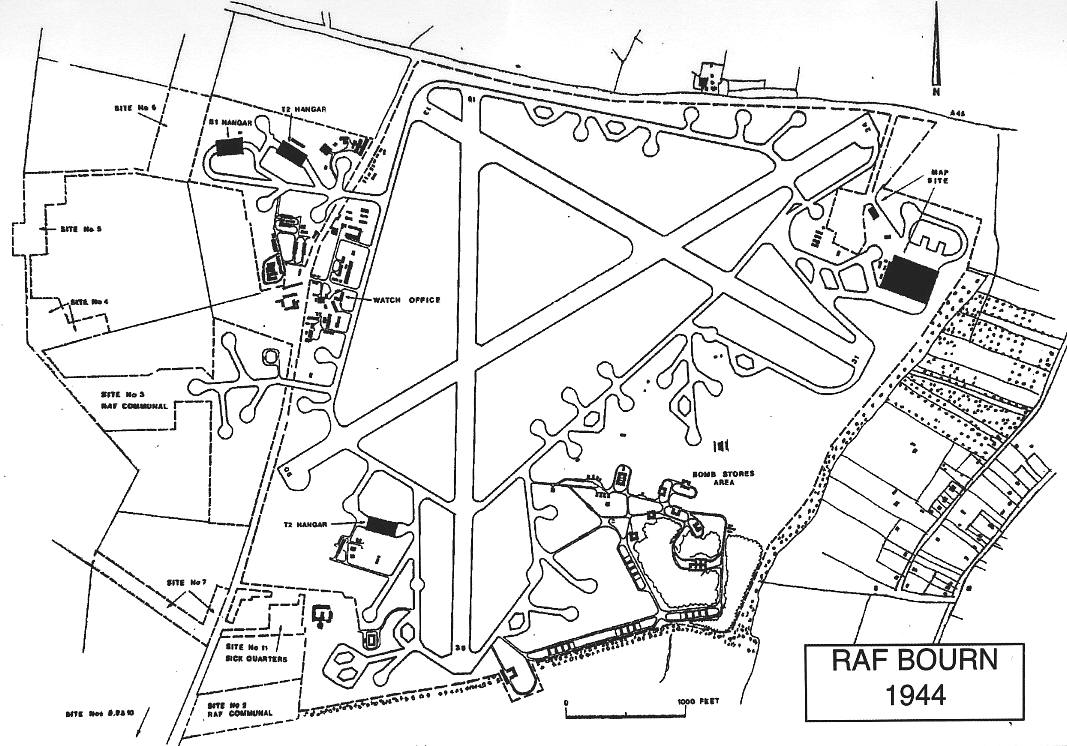Bourn
BOURN: Military aerodrome later civil aerodrome
Note. Pictures by the author unless specified.
Military users: WW2: RAF Bomber Command 8 Group
15 Sqdn (Short Stirlings)
97 Sqdn (Avro Lancasters)
101 Sqdn (Vickers Wellingtons)
105 Sqdn (DH Mosquitos)
1696 (B) DFT (Vickers-Supermarine Spitfires & Hawker Hurricanes)
Operated by: Post 1945: In the 1980s this was a helicopter base operated by Bond Helicopters. Light aircraft also used part of this disused WW2 aerodrome. GA operator: 1980s till present day(?) = Rural Flying Corps
Map courtesy of GMS Enterprises
Activities: Post 1945: GA private, training and maintenance
Crop-spraying: Fison-Airwork:
In the 1957 The Aeroplane directory, the Fison-Airwork fleet, based here, is given as seven Hiller 360 helicopters plus two Westland S.55 Whirlwinds.
Flying schools: Post 1945: Rural Flying Corps
Location: S of A45, (now A14), W of Highfields, 7 nm W of Cambridge
Period of operation: 1941 to 1948 military. Then civil, from when? To -
Note: The first map is reproduced with the kind permission of Pooleys Flight Equipment Ltd. Copyright Robert Pooley 2014. The second map is also based on a Pooleys Flight Equipment image but was scanned from the AAIB Bulletin 09/2017. This shows the new shorter and thinner runway which runs parallel to and west of the old 18/36 WW2 runway.
Runways: WW2: 06/24 1760x46 hard 18/36 1463x46 hard
12/30 1280x46 hard
1990: 01/19 633x18 hard
2001: 01/19 633x18 hard 06/24 568x18 hard
2017: 18/36 600 hard/grass
Note: Roughly speaking the northen section is grass and the southern section hard
NOTES: During 1944 at least, staffed by 1,827 airmen and 234 WAAFs.
In 2004 runway 01/19 was reclassified as being 18/36. In 1975 the main activities were listed as being helicopter and crop spraying aircraft. In attempting to include the typical make-up of the GA ‘fleet’ based here in 1977 according to a listing published by P E Enterprises in 1977 the first listing, G-AOZS, doesn’t appear in the 1977 edition of Civil Aircraft Markings by John W R Taylor, nor did G-ASIH! The subject of aviation research is, I have found, riddled with such anomalies so thank heavens I don’t need to sort them out. This is just a Guide and nothing more.
This said, from a web search it would appear that G-AOZS was a Hiller UH-12C and G-ASIH a Hiller UH-12E so perhaps they were used for spares, or just surplus to requirements. Operational at that time were the Hiller UH-12E helicopters G-ATVG, G-AVKX, G-AVKY, G-AZSV, G-BBAZ and G-BBBA, plus the MBB Bo.105D G-BCXO. Apparently all based here operated by Management Aviation Ltd presumably on crop-spraying duties. The exception to this is MBB Bo.105D G-BDYZ which appeared to be registered to Helicopter Marketing Ltd.
WW2 HISTORY
97 Squadron were one of the 'Pathfinder' squadrons, a concept pioneered by the Australian Group Captain Donald Bennett. It is a myth that the 'Pathfinders' were comprised of the elite. Some were and many weren't. Quite often the 'Pathfinders' set their marker flares over the wrong targets.
But what I think is very interesting is why Bomber Command didn't really target the synthetic oil production facilities. General Spaatz of the USAAF had identfied these as being critical, and made them priority targets. And he was quite correct. Without fuel the Nazi war machine would have very quickly ground to a halt. What wasn't realised in Bomber Command HQ was that a target, apparently being destroyed, could be quite quickly rebuilt and back in production. Indeed, Albert Speer had crack teams assembled to achieve this
This lack of understanding probably prolonged the war for between six months to a year. Indeed, after the war several major people serving the Nazi regime could not understand why the Allies failed to attack, consistently, oil production plants. With hindsight perhaps, this seems an incredible lack of understanding about how a modern miltary 'machine' works.
In fact, it now appears, that the Nazi regime did not lack resources and armaments, right up to the end. What they did lack was manpower, especially skilled men. It seems that unlike the Allies, Hitler was totally opposed to using women in industry.
Peter Haden
This comment was written on: 2018-08-09 10:13:47A further military user was 162 Squadron, RAF, re-formed in Bourn in December 1944 as part of the Light Night Striking Force.
We'd love to hear from you, so please scroll down to leave a comment!
Leave a comment ...
Copyright (c) UK Airfield Guide



















